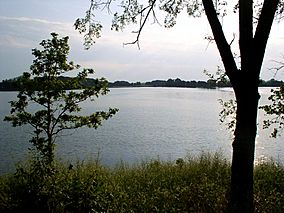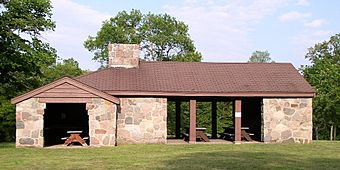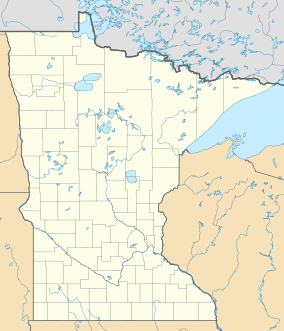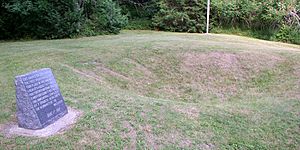Monson Lake State Park facts for kids
Quick facts for kids Monson Lake State Park |
|
|---|---|

Monson Lake
|
|
| Location | Swift, Minnesota, United States |
| Area | 346 acres (140 ha) |
| Elevation | 1,253 ft (382 m) |
| Established | 1937 |
| Governing body | Minnesota Department of Natural Resources |
|
Monson Lake State Park CCC/WPA/Rustic Style Historic Resources
|
|

Monson Lake State Park's Combination Building
|
|
| Lua error in Module:Location_map at line 420: attempt to index field 'wikibase' (a nil value). | |
| Location | Swift County, Minnesota, off Co. Rd. 95 SE of Sunburg |
|---|---|
| Nearest city | Sunburg, Minnesota |
| Area | 31 acres (13 ha) |
| Built | 1936–1938 |
| Architectural style | National Park Service rustic |
| MPS | Minnesota State Park CCC/WPA/Rustic Style MPS |
| NRHP reference No. | 89001666 |
| Added to NRHP | October 25, 1989 |
Monson Lake State Park is a special place in Minnesota, USA. It was created to remember 13 Swedish American pioneers. They were killed here during the Dakota War of 1862.
The park has historic buildings from the 1930s. These buildings are listed on the National Register of Historic Places. Even though the park grew bigger in 2009, it's still one of Minnesota's smaller state parks. You can find it near Sunburg. The park is managed by staff from nearby Sibley State Park.
Contents
Exploring the Park's Location
Much of Monson Lake State Park is covered by water. The land forms narrow strips between three lakes: Monson, West Sunburg, and East Sunburg.
Monson Lake is about 152 acres (62 ha) and up to 21 feet (6.4 m) deep. West Sunburg Lake is around 178 acres (72 ha). Monson Lake has three streams flowing into it. One stream flows out into West Sunburg Lake. These lakes are part of the Chippewa River system. This river eventually flows into the Minnesota River.
Nature at Monson Lake State Park
How the Land Was Formed
Monson Lake State Park sits on a chain of lakes and rolling hills. This area is called the Alexandria Moraine. It was created about 30,000 years ago. Giant sheets of ice, called glaciers, moved across the land. They left behind rocks and dirt, forming these hills.
Large chunks of ice broke off the glacier. These ice chunks melted in place. This created the park's three bowl-shaped lakes, known as kettle lakes.
Plants and Trees You Might See
Before European settlers arrived, this area was mostly tallgrass prairie. There were groups of trees where lakes protected them from wildfires.
Today, the park has many trees. You'll find basswood, bur oak, and green ash. There are also some northern red oak trees. Smaller trees like ironwood are common. The ground is often covered with Virginia waterleaf.
You can also spot beautiful wildflowers. These include nodding trillium and large-flowered bellwort. Other flowers are Dutchman's breeches, bloodroot, jack-in-the-pulpit, and starry false Solomon seal. About 42 acres (17 ha) of the park is covered by these forests.
Near the lakes and in marshy areas, you'll see plants that grow out of the water. These include prairie bulrush, bur-reed, arrowhead, and spikerush.
Unfortunately, two plants that don't belong here have spread. These are common buckthorn and reed canary grass. They can harm the native plants.
Animals and Birds You Might See
Many animals live in Monson Lake State Park. You might see white-tailed deer, groundhogs, minks, foxes, and squirrels. Eastern chipmunks are also common.
The park is on a major bird migration path called the Mississippi Flyway. This means many different birds visit the park. Some rare birds seen here include Henslow's sparrows and American white pelicans. You might also spot Forster's terns, Franklin's gulls, horned grebes, and trumpeter swans.
Water Quality in the Lakes
In 2005, a study found that Monson Lake has clear water. It has low to medium levels of nutrient pollution. This pollution mostly comes from nearby farms. The plants growing in and around the water are healthy and diverse.
Sometimes, Monson Lake has cyanobacteria blooms in the summer. These are like tiny plant growths that can make the water look green. But the lake does not have harmful invasive water plants like Eurasian water milfoil. West Sunburg Lake also has very good water quality.
Park Climate
The park has a humid continental climate. This means there are big differences in temperature between summer and winter. The average temperature in July is 71.8 °F (22.1 °C). In January, it's about 9.7 °F (−12.4 °C).
The park gets about 31.67 inches (80.4 cm) of rain each year. The average snowfall is 53.6 inches (136 cm). Plants usually grow for about 156 days each year.
History of Monson Lake State Park
Early Native American Life
Archaeologists have found three sites in the park. These show that Native Americans lived here a very long time ago. They were here during the Woodland period (1000 BCE to 1000 CE).
Tools found at these sites tell us a lot. They used stone tools made from obsidian from the Great Plains. They also used flint from North Dakota and quartzite from Wisconsin. This shows they were part of a large trade network.
European Settlers Arrive
In 1861, two brothers from Sweden, Anders and Daniel Broberg, bought land here. This area was then the very edge of the settled frontier. The Broberg families, along with their neighbors, formed the West Lake Settlement.
At the same time, the native Dakota people faced many challenges. Their traditional way of life was becoming harder. They were forced onto reservations. Treaties were broken, and payments from the United States government were late or unfair. This caused hunger and hardship for the Dakota people.
The Attack at the Broberg Cabin (1862)
On August 20, 1862, most settlers in West Lake didn't know that fighting had started. A church service was being held at a nearby cabin. The Brobergs and Omans attended, leaving some children at home.
About 30 Dakota warriors visited the Broberg cabin. They were dressed for war and seemed unfriendly. Seven-year-old Peter Broberg was sent to get the adults. Anders Broberg and four Lundborg sons quickly came to the cabin.
The situation quickly became dangerous. Anders and the Lundborg boys were shot. Samuel Lundborg was hurt but survived. Andreas Lundborg arrived and ran when he saw the attack. The warriors then focused on a wagon carrying Daniel Broberg and the women and children. Daniel was shot, and 7-year-old Christiana was hit.
Sixteen-year-old Anna Stina escaped into a cornfield. Her cousin Peter ran to the Oman cabin. A warrior took Peter's baby brother from his mother and threw him down. The warriors tried to capture the two Mrs. Brobergs, but they resisted and were shot.
The Dakota killed three children and one adult left in the Broberg cabin. They then looted the Lundborg cabin. The elder Lundborg and Anna Stina Broberg hid and survived. Peter Broberg and the Oman family hid in their cellar.
After the Dakota left, the Omans hid until after sunset. They spent the night in the woods. The survivors gathered on an island in a nearby lake. Two days later, settlers buried the 13 victims in a field. Peter and the younger Anna Stina were the only ones from their families to survive.
Many settlers left the area as the conflict grew. Anna Stina and Peter returned three years later. The victims were reburied in New London, Minnesota, in 1891. A state-funded monument was placed there. Peter Broberg put a memorial marker at the cabin site in 1917.
Creating the Monson Lake Memorial
In 1926, a local resident named Ole Ellingboe had an idea. He wanted to preserve the Broberg cabin site as a park. The idea was popular. In 1927, the Monson Lake Memorial Association was formed. They raised money to buy 2 acres (0.81 ha) of land.
The dedication of the private memorial park in 1927 drew 10,000 people. The Association held popular yearly events. These included speeches, plays, music, and food. State and national leaders often attended. The largest event, in 1958, had 15,000 visitors.
For many years, these events focused only on the European American settlers. In 1987, the events began to include the story of the Dakota people.
New Deal Projects at the Park
The park was first owned by the Monson Lake Memorial Association. During the Great Depression, the government started projects to create jobs. Building parks was a big part of this.
In 1935, the Minnesota Emergency Relief Agency bought and expanded the park. The Veterans Conservation Corps (VCC) helped build things. This group was part of the Civilian Conservation Corps for unemployed World War I veterans.
In 1936, a VCC camp was set up at Monson Lake. The VCC men built a Sanitation Building and a Combination Building. The Combination Building was a picnic shelter with a cooking area. These buildings were made in a rustic style using local granite and white oak. Workers from the Works Progress Administration built the park's entrance road and parking lot.
Monson Lake Memorial State Park was officially dedicated in 1938. Because it was a memorial park, only a few recreational facilities were built.
In 1989, 31 acres (13 ha) of the park, including these historic buildings, were added to the National Register of Historic Places. The park has not changed much since it was built.
Later Park History
In 1956, the park's name was shortened to Monson Lake State Park. Over the years, more things were added. These included staff buildings, showers, a boat ramp, and signs. In 1962, a memorial plaque was added.
For many decades, Monson Lake State Park was 187 acres (76 ha). In the mid-2000s, the park grew much larger. Owners of land to the east decided to sell to the state. This added 158 acres (64 ha) to the park. This new land included most of West Sunburg Lake and part of East Sunburg Lake. The state bought the land in 2009. The new area has 44 acres (18 ha) of land and 114 acres (46 ha) of water. It will be managed as a refuge for waterfowl.
Fun Things to Do at Monson Lake State Park
Monson Lake State Park offers many activities. You can enjoy birdwatching, camping, canoeing, fishing, hiking, and picnicking.
The campground has 20 sites and is open in summer. There's a boat ramp on Monson Lake. You can fish for walleye, northern pike, largemouth bass, black crappie, yellow perch, and bluegill. Walleye are added to the lake every two years.
There are 1.2 miles (1.9 km) of trails in the park. You can take a canoe trip from the boat ramp across Monson Lake. Then, you can carry your canoe 463 feet (141 m) to West Sunburg Lake. In winter, you can go snowshoeing anywhere in the park.




